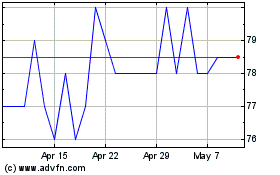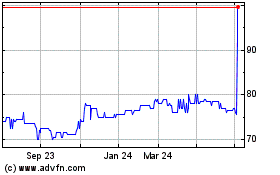Lloyd's of London, the U.K.'s 324-year-old insurance and
reinsurance market, Wednesday posted its first pretax loss in six
years after being hit by lower investment returns and major
catastrophes, in what industry experts call the second-costliest
year on record in terms of insured disaster claims.
Lloyd's also said 2012 remains challenging for insurers with
tough economic conditions globally. And despite the losses,
insurance rates may rise only slowly because insurers have bulked
up on capital, especially during years with smaller catastrophe
claims.
For 2011, the Lloyd's market had a pretax loss of GBP516
million, compared with a pretax profit of GBP2.2 billion a year
earlier, consisting of the sum result of its members and itself as
the managing corporation.
The loss comes as industry estimates show that total claims from
natural catastrophes last year were between $100 billion and $116
billion, the second-highest on record after 2005, when strong
hurricanes in the U.S. pushed the figure to $120 billion.
Willis Re said catastrophe losses last year were worth at least
$100 billion. Aon Benfield puts the figure at $107 billion and
Swiss Re (SREN.VX) puts it at $116 billion.
Lloyd's Chief Executive Richard Ward said: "Make no mistake,
2011 was a difficult year for the insurance industry. Given the
scale of the claims, a loss is unsurprising, but it reflects what
we're here to do--help communities and businesses rebuild after
disaster."
"However, I am disappointed that, given the exceptional level of
catastrophes in 2011, insurance rates have not responded more
positively. These events demonstrate the need for the industry to
show discipline in terms of pricing," Ward said.
Ward said in a Bloomberg TV interview that the insured losses in
2011 "don't happen every year."
"When we do have these significant claims coming in, yes, the
market reports a loss. But when claims don't come in, the market
reports a profit," he said.
"It's important that we're here to pay the claims of
policyholders. We've been doing that for 324 years, we're building
our financial strength so we can do that in the next 324 years,"
Ward said.
Lloyd's new chairman, John Nelson, noted that Lloyd's was able
to make a profit in the second half of the year despite the floods
in Thailand and continuing low investment returns.
"2012 remains challenging for insurers with tough economic
conditions globally. It is vital that the market continues to take
a disciplined approach to underwriting," Nelson said.
Lloyd's investment return fell to GBP955 million from GBP1.26
billion in 2010 amid poor investment markets.
Lloyd's said its combined ratio worsened to 106.8% from 93.3%. A
combined ratio is a measure of claims costs compared with premiums.
A figure below 100% indicates an underwriting profit. Conversely, a
figure above 100% indicates a loss.
Lloyd's last had a pretax loss in 2005 worth GBP103 million.
Before that was 2001 with a loss of GBP3.1 billion.
Lloyd's Finance Director Luke Savage told Dow Jones Newswires
that 2011 was one of the costliest for Lloyd's. Despite that,
insurance rates may only see sluggish growth.
"When you have major claims like earthquakes and windstorms
outside the U.S., we tend to have a higher share of claims than
from inside the U.S. Last year, there were major disasters in
Australia, New Zealand, Japan and Thailand, so we picked up a
higher share than we normally do," he said.
Savage said only a few lines of insurance are seeing increased
rates but even those increases are "not enough."
"We've seen property treaty improving, as well as in energy, and
there's a big improvement in U.K. motor rates, but that's just
trying to claw back previous losses," he said.
"Beyond that, rates are still sluggish because of excess capital
in the industry. It's going to be difficult to drive rates up, even
though we don't think there's going to be much in the way of
investment returns to support underwriting," Savage said.
Excess capital means that insurers have enough funds to back the
offering of new insurance policies. That increases competition and
makes it difficult to raise premium prices.
Savage said Lloyd's central fund--a pool of money used in case
troubled member insurers have difficulty paying claims--has risen
to GBP3.095 billion from GBP3.028 billion in 2010. "This shows
we're in pretty good shape in a pretty disciplined market," he
said.
Savage said Lloyd's managed to post a GBP181 million pretax
profit in the second half of last year despite the floods in
Thailand.
Lloyd's isn't publicly traded, though some of its members are
listed companies, such as Hiscox Ltd. (HSX.LN), Catlin Group Ltd.
(CGL.LN) and Hardy Underwriting Bermuda Ltd. (HDU.LN).
Shore Capital analyst Eamonn Flanagan said in a recent note that
the strong level of capital of general insurance companies is like
a "double-edged sword."
On the one hand, Flanagan said, tight management of capital has
enabled the non-life industry to endure the huge insured
catastrophe losses in 2011.
But on the other hand, "such financial strength has hampered
attempts to push through much-needed hardening of premium rates in
many key lines, especially liability, despite the low interest-rate
environment" Flanagan said.
"The non-life insurance industry has stood firm, paid its claims
and continued to provide cover--all without assistance from the
beleaguered taxpayer. For this, we must give management throughout
the industry considerable credit," he said.
Analysts from Oriel Securities said there may be "more
pronounced increases" in rates in April and July insurance
contracts in Asia-Pacific are renewed.
- By Vladimir Guevarra, Dow Jones Newswires. Tel. +44 (0)
2078429486, vladimir.guevarra@dowjones.com
Castelnau (LSE:CGL)
Historical Stock Chart
From Mar 2024 to Apr 2024

Castelnau (LSE:CGL)
Historical Stock Chart
From Apr 2023 to Apr 2024
